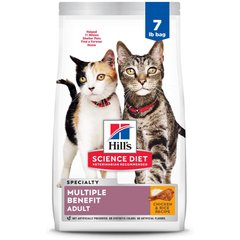What Can’t Cats Eat? 8 Toxic Foods for Cats
mapo/iStock/Getty Images Plus via Getty Images
The urge to treat your cat to a bite or two of human food is understandable. However, some of your favorite foods can pose a serious health risk to cats—even in small amounts. So, what can’t cats eat?
Here are the most common toxic foods for cats, their effects, and what to do if your cat happens to eat something dangerous.
Check with your veterinarian before feeding your cat any human food, especially if your cat has any medical issues, is on prescription medications, or eats prescription food.
Key Takeaways
- Members of the onion family, including garlic, are extremely toxic to cats, but other foods can be very dangerous too.
- Cats develop different symptoms depending on which toxic food and how much of it they have eaten, but vomiting, diarrhea, and lethargy are common.
- Immediately call a veterinarian or the Pet Poison Helpline (855-764-7661; a consultation fee applies) if you think your cat has eaten a toxic food.
What Foods Are Toxic to Cats?
Knowing what cats can’t eat is important because it can help prevent some seriously unwanted side effects, from gastrointestinal (GI) upset (such as vomiting) to seizures and even death.
Topping the list of “What can cats not eat?” are the following foods, which are the most poisonous to cats.

Onions, Garlic, and Related Foods
Onions, garlic, leeks, chives, and shallots contain sulfur compounds that are toxic to cats because they damage their red blood cells. These damaged cells die more rapidly than normal, causing anemia (a low red blood cell count), which can be fatal.
Clinical signs include:
-
Vomiting
-
Increased heart rate
-
Yellow mucous membranes and skin
-
Dark urine
-
Rapid breathing
-
Weakness or collapse
-
Seeking out warm spaces
Chocolate
Chocolate contains theobromine and caffeine, stimulants called methylxanthines that are toxic to cats. The darker a chocolate is, the more methylxanthines it usually contains.
After a cat eats chocolate, they might experience:
-
Vomiting
-
Diarrhea
-
Hyperexcitability
-
Seizures
-
Increased heart rate
-
Difficulty walking
Caffeinated Drinks
Like chocolate, drinks that contain a lot of caffeine (a methylxanthine stimulant) are dangerous for cats.
Signs of a significant caffeine exposure in cats include:
-
Vomiting
-
Diarrhea
-
Hyperexcitability
-
Tremors
-
Seizures
-
Irregular heart rhythm
Alcohol
Alcohol makes cats sick by depressing their nervous system, irritating their digestive tract, and altering their acid-base balance.
Because of their small size, cats don’t have to drink much alcohol to develop clinical signs, including:
-
Nausea
-
Vomiting
-
Diarrhea
-
Increased thirst and urination
-
Lethargy and weakness
-
Unsteadiness (ataxia)
-
Disorientation
-
Slow breathing
-
Muscle tremors
-
Seizures
-
Coma
-
Low body temperature (hypothermia)
-
Low blood sugar (hypoglycemia)
Raw Dough
While cats can safely eat a small amount of baked bread, raw dough poses a threat.
The live yeast contained in raw dough can continue to produce gas and alcohol inside a cat’s stomach, leading to clinical signs such as:
-
A bloated, gas-filled stomach
-
Abdominal pain
-
Vomiting
-
Diarrhea
-
Signs of alcohol poisoning (see above), including disorientation, weakness, slow breathing, and seizures
Grapes, Raisins, Tamarinds, and Cream of Tartar
Cats can develop kidney failure after eating grapes, raisins, tamarinds, and cream of tartar, which are all toxic foods for cats.
If your cat consumes any of these foods—even a tiny amount—contact your local veterinarian, veterinary ER, or poison control right away. Kidney failure can develop quickly and can be fatal.
Recent studies in dogs suggest that tartaric acid is the compound toxic in these foods, and until more is known, it’s recommended cats avoid eating these foods. Consuming them can lead to the following symptoms:
-
Vomiting
-
Diarrhea
-
Poor appetite
-
Lethargy
-
Increased thirst and urination
-
Little or no urine production as the cat’s condition worsens
Raw Meat, Poultry, Fish, Eggs, and Dairy
Raw foods aren’t always a problem, but feeding raw animal products to cats increases the chances that they will be exposed to pathogens such as salmonella, E. coli, campylobacter, and avian influenza.
Clinical signs of a food-borne illness include:
-
Poor appetite
-
Lethargy
-
Abdominal pain
-
Vomiting
-
Diarrhea
-
Fever
Citrus
The flesh of oranges, lemons, limes, and other citrus fruits is not toxic to cats. However, their skins contain irritating oils and other compounds that can lead to clinical signs such as:
-
Vomiting
-
Diarrhea
-
Irritated skin
What To Do if Your Cat Eats Toxic Foods
Call your veterinarian, a veterinary emergency hospital, or a veterinary toxicologist immediately if you think your cat has eaten something toxic. You’ll want to act quickly because treatment works best when it’s started early.
Treat your pet at home only if a veterinarian or veterinary toxicologist tells you that you should. Administering the wrong treatment could make matters worse. For example, if you make a pet throw up when they can’t swallow well, they might inhale food particles and develop aspiration pneumonia.
The Pet Poison Helpline (855-764-7661; a consultation fee applies) or the ASPCA Animal Poison Control Center (888-426-4435; a consultation fee might apply) can provide expert advice if your feline friend has eaten a food poisonous to cats.
To help prevent begging or the urge to steal food, feed your cat a complete-and-balanced cat food from a reputable brand, like Hill's Pet Nutrition or Royal Canin, and ensure they are getting enough food to satisfy their daily caloric needs.



